Yamaha PW50, PW50F, PW50F1 User Manual

 Read this manual carefully before operating this vehicle.
Read this manual carefully before operating this vehicle.
 Il convient de lire attentivement ce manuel avant la première utilisation du véhicule.
Il convient de lire attentivement ce manuel avant la première utilisation du véhicule.
 Bitte lesen Sie diese Bedienungsanleitung sorgfältig durch, bevor Sie das Fahrzeug in Betrieb nehmen.
Bitte lesen Sie diese Bedienungsanleitung sorgfältig durch, bevor Sie das Fahrzeug in Betrieb nehmen.
OWNER’S MANUAL MANUEL DU PROPRIÉTAIRE BEDIENUNGSANLEITUNG
PW50
PW50F
PW50F1
2SA-28199-81

Original instructions Notice originale Originalbetriebsanleitung
PRINTED ON RECYCLED PAPER IMPRIMÉ SUR PAPIER RECYCLÉ AUF RECYCLINGPAPIER GEDRUCKT
PRINTED IN JAPAN 2014.06-1.4×1 CR (E,F,G)
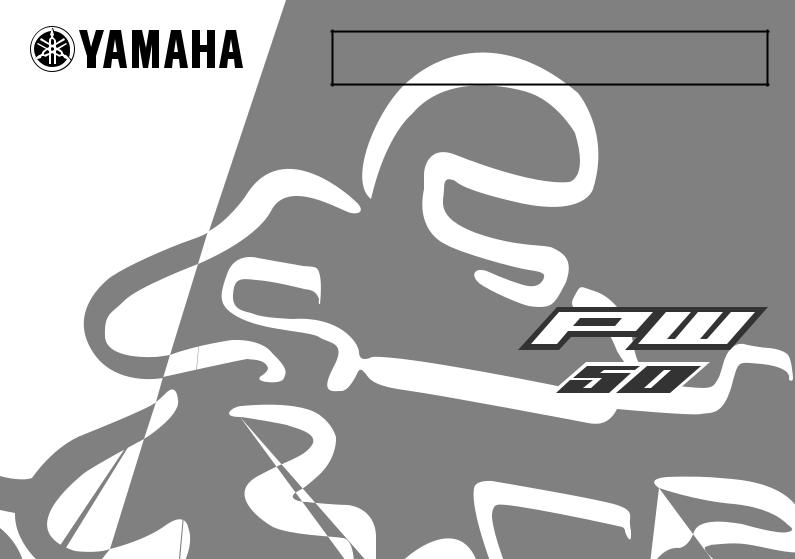
 Read this manual carefully before operating this vehicle.
Read this manual carefully before operating this vehicle.
OWNER’S MANUAL
PW50
PW50F
PW50F1
2SA-28199-81-E0

EAU48176
 Read this manual carefully before operating this vehicle. This manual should stay with this vehicle if it is sold.
Read this manual carefully before operating this vehicle. This manual should stay with this vehicle if it is sold.
EC Declaration of Conformity
conforming to Directive 98/37/EC, 2006/42/EC
We,YAMAHA MOTOR CO., LTD. 2500 Shingai, Iwata, Japan, declare in sole responsibility, that the product
PW50 (JYA3PT00000045774– )
(Make, model)
to which this declaration applies, conforms to the essential health and safety requirements of Directive 98/37/EC, 2006/42/EC
(If applicable)
and to the other relevant Directives of EEC 2004/108/EC
(Title and/or number and date of issue of the other Directives of EEC)
(If applicable)
To effect correct application of the essential health and safety requirements stated in the Directives of EEC, the following-standards and/or technical specifications were consulted:
– –
(Title and/or number and date of issue of standards and/or specifications)
Authorized Representative
YAMAHA MOTOR EUROPE N.V.
Koolhovenlaan 101, 1119 NC Schiphol-Rijk, The Netherlands
Signature
Toshiharu Shigeta
Division Manager
Motorcycle Headquarters
PF Development Operations
Date of Issue 18 April , 2014
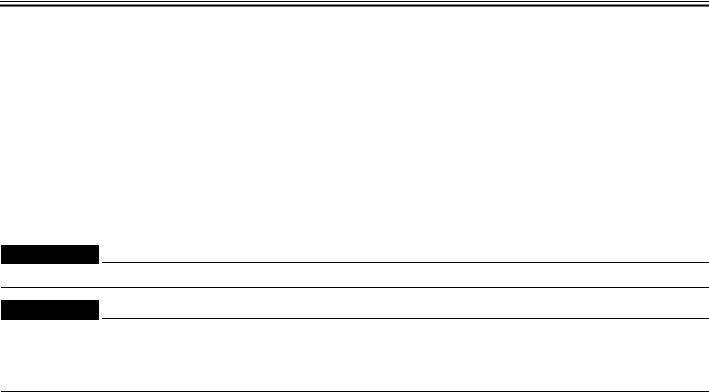
INTRODUCTION
EAU41075
Congratulations on your purchase of the Yamaha PW50/PW50F/PW50F1. This model is the result of Yamaha’s vast experience in the production of fine sporting, touring, and pacesetting racing machines. It represents the high degree of craftsmanship and reliability that have made Yamaha a leader in these fields.
This manual will give you an understanding of the operation, inspection, and basic maintenance of this motorcycle. If you have any questions concerning the operation or maintenance of your motorcycle, please consult a Yamaha dealer.
The design and manufacture of this Yamaha motorcycle fully comply with the emissions standards for clean air applicable at the date of manufacture. Yamaha has met these standards without reducing the performance or economy of operation of the motorcycle. To maintain these high standards, it is important that you and your Yamaha dealer pay close attention to the recommended maintenance schedules and operating instructions contained within this manual.
Yamaha continually seeks advancements in product design and quality. Therefore, while this manual contains the most current product information available at the time of printing, there may be minor discrepancies between your motorcycle and this manual. If there is any question concerning this manual, please consult a Yamaha dealer.
EWA10032
 WARNING
WARNING
Please read this manual carefully and completely before operating this motorcycle.
EWA14352
 WARNING
WARNING
This motorcycle is designed and manufactured for off-road use only. It is illegal to operate this motorcycle on any public street, road or highway. Such use is prohibited by law. This motorcycle complies with almost all state offhighway noise level and spark arrester laws and regulations. Please check your local riding laws and regulations before operating this motorcycle.
AN IMPORTANT SAFETY MESSAGE:
Read this manual carefully and completely before operating this motorcycle. Make sure you understand all instructions.
Pay close attention to the warning and notice labels on the motorcycle.
Never operate a motorcycle without proper training or instruction.
Weight of the rider should not exceed 25 kg (55 lb).

INTRODUCTION
AN IMPORTANT NOTE TO PARENTS:
This motorcycle is not a toy. Before you let your child ride this motorcycle, you should understand the instructions and warnings in this Owner’s Manual. Then be sure your child understands and will follow them. Children differ in skills, physical abilities, and judgment. Some children may not be able to operate a motorcycle safely. Parents should supervise their child’s use of the motorcycle at all times. Parents should permit continued use only if they determine that the child has the ability to operate the motorcycle safely.
Your motorcycle is equipped with an adjustable speed limiter and a power reduction plate. Yamaha recommends that all beginners start off with the speed limiter adjusting screw turned in and the power reduction plate installed in the exhaust manifold to limit the power available while they learn. The limiter screw may be gradually turned out to increase maximum speed as the beginner becomes more familiar with operating the motorcycle. Parents should decide when to adjust the motorcycle for more power as their youngster’s riding skills improve. Once the rider can operate with skill at the top speed permitted by adjusting the speed limiter alone, the power reduction plate can be removed. Since removal of this plate will result in a significant increase in power, turn the speed limiter back in again; adjust it out in stages as you did before.
Motorcycles are single track vehicles. Their safe use and operation are dependent upon the use of proper riding techniques as well as the expertise of the operator. Every operator should know the following requirements before riding this motorcycle.
He or she should:
Obtain thorough instructions from a competent source on all aspects of motorcycle operation.
Observe the warnings and maintenance requirements in this Owner’s Manual.
Obtain qualified training in safe and proper riding techniques.
Obtain professional technical service as indicated in this Owner’s Manual and/or when made necessary by mechanical conditions.

IMPORTANT MANUAL INFORMATION
EAU10134
Particularly important information is distinguished in this manual by the following notations:
|
|
|
|
This is the safety alert symbol. It is used to alert you to potential personal injury |
|
|
|
|
hazards. Obey all safety messages that follow this symbol to avoid possible injury |
|
|
|
|
or death. |
|
|
|
|
|
|
|
|
|
|
|
|
|
|
A WARNING indicates a hazardous situation which, if not avoided, could result in |
|
WARNING |
|
||
|
|
death or serious injury. |
||
|
|
|
|
|
|
|
|
|
|
|
|
|
|
|
|
|
|
|
A NOTICE indicates special precautions that must be taken to avoid damage to the |
|
NOTICE |
|
|
|
|
|
vehicle or other property. |
||
|
|
|
|
|
TIP |
A TIP provides key information to make procedures easier or clearer. |
|
|
*Product and specifications are subject to change without notice.
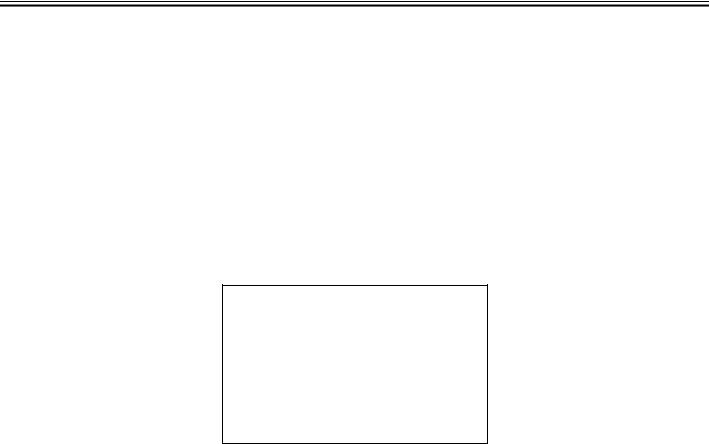
IMPORTANT MANUAL INFORMATION
EAU10201
PW50/PW50F/PW50F1
OWNER’S MANUAL
©2014 by Yamaha Motor Co., Ltd. 1st edition, May 2014
All rights reserved.
Any reprinting or unauthorized use without the written permission of Yamaha Motor Co., Ltd.
is expressly prohibited. Printed in Japan.

TABLE OF CONTENTS
LOCATION OF IMPORTANT |
|
LABELS.............................................. |
1-1 |
SAFETY INFORMATION ................... |
2-1 |
DESCRIPTION ................................... |
3-1 |
Left view .......................................... |
3-1 |
Right view........................................ |
3-2 |
Controls and instruments................ |
3-3 |
INSTRUMENT AND CONTROL |
|
FUNCTIONS....................................... |
4-1 |
Handlebar switch ............................ |
4-1 |
Speed limiter and power reduction |
|
plate ............................................. |
4-1 |
Front brake lever ............................. |
4-2 |
Rear brake lever .............................. |
4-3 |
Fuel tank cap................................... |
4-3 |
Fuel.................................................. |
4-3 |
Fuel tank breather hose................... |
4-5 |
2-stroke engine oil........................... |
4-6 |
Fuel cock......................................... |
4-6 |
Starter (choke) lever ....................... |
4-7 |
Kickstarter ....................................... |
4-7 |
Seat ................................................. |
4-7 |
Cable lock (for Europe).................... |
4-8 |
FOR YOUR SAFETY – |
|
PRE-OPERATION CHECKS............. |
5-1 |
OPERATION AND IMPORTANT |
|
RIDING POINTS ................................ |
6-1 |
Starting and warming up a cold |
|
engine.......................................... |
6-1 |
Starting a warm engine................... |
6-1 |
Starting off ...................................... |
6-2 |
Acceleration and deceleration ........ |
6-2 |
Braking............................................ |
6-2 |
Engine break-in............................... |
6-3 |
Parking............................................ |
6-4 |
PERIODIC MAINTENANCE AND |
|
ADJUSTMENT .................................. |
7-1 |
Owner’s tool kit............................... |
7-2 |
Periodic maintenance chart for the |
|
emission control system ............. |
7-3 |
General maintenance and |
|
lubrication chart .......................... |
7-4 |
Checking the spark plug................. |
7-6 |
Removing the power reduction |
|
plate............................................. |
7-7 |
Transmission oil.............................. |
7-8 |
Middle and final gear cases............ |
7-9 |
Cleaning the air filter element ......... |
7-9 |
Cleaning the spark arrester .......... |
7-10 |
Adjusting the carburetor ............... |
7-11 |
Adjusting the engine idling |
|
speed......................................... |
7-11 |
Checking the throttle grip free |
|
play ............................................ |
7-12 |
Tires .............................................. |
7-12 |
Panel wheels ................................. |
7-14 |
Adjusting the front and rear brake |
|
lever free play ............................ |
7-14 |
Checking the front and rear brake |
|
shoes ......................................... |
7-15 |
Checking and lubricating the |
|
cables ........................................ |
7-16 |
Checking and lubricating the |
|
throttle grip and cable ............... |
7-16 |
Adjusting the Autolube pump ....... |
7-16 |
Lubricating the front and rear |
|
brake levers ............................... |
7-17 |
Checking and lubricating the |
|
centerstand................................ |
7-17 |
Checking the front fork ................. |
7-17 |
Checking the steering ................... |
7-18 |
Checking the wheel bearings........ |
7-18 |
Front wheel ................................... |
7-19 |
Rear wheel .................................... |
7-20 |
Troubleshooting ............................ |
7-23 |
Troubleshooting chart ................... |
7-24 |
MOTORCYCLE CARE AND |
|
STORAGE .......................................... |
8-1 |
Matte color caution ......................... |
8-1 |
Care................................................. |
8-1 |
Storage............................................ |
8-3 |

TABLE OF CONTENTS
SPECIFICATIONS............................. |
9-1 |
CONSUMER INFORMATION ......... |
10-1 |
Identification numbers.................. |
10-1 |
INDEX.............................................. |
11-1 |
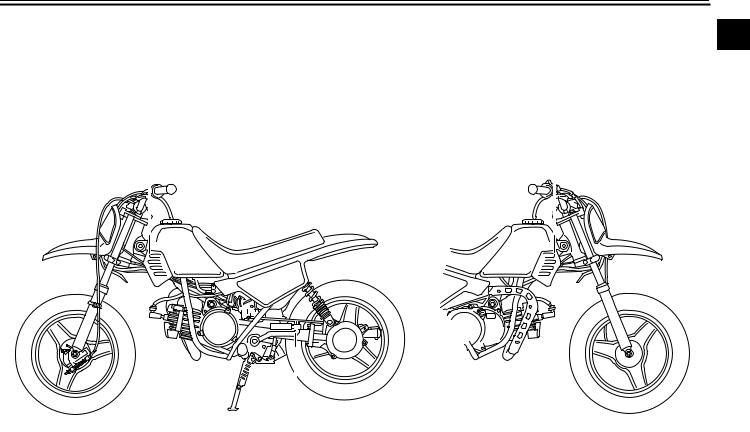
LOCATION OF IMPORTANT LABELS
EAU48116
1
Read and understand all of the labels on your vehicle. They contain important information for safe and proper operation of your vehicle. Never remove any labels from your vehicle. If a label becomes difficult to read or comes off, a replacement label is available from your Yamaha dealer.
For Canada
1 |
2 |
3,4 |
7 |
||||||||||||||||||||||||||||
|
|
|
|
|
|
|
|
|
|
|
|
|
|
|
|
|
|
|
|
|
|
|
|
|
|
|
|
|
|
|
|
|
|
|
|
|
|
|
|
|
|
|
|
|
|
|
|
|
|
|
|
|
|
|
|
|
|
|
|
|
|
|
|
|
|
|
|
|
|
|
|
|
|
|
|
|
|
|
|
|
|
|
|
|
|
|
|
|
|
|
|
|
|
|
|
|
|
|
|
|
|
|
|
|
|
|
|
|
|
|
|
|
|
|
|
|
|
|
|
|
|
|
|
|
|
|
|
|
|
|
|
|
|
|
|
|
|
|
|
|
|
|
|
|
|
|
|
|
|
|
|
|
|
|
|
|
|
|
|
|
|
|
|
|
|
|
|
|
|
|
|
|
|
|
|
|
|
|
|
|
|
|
|
|
|
|
|
|
|
|
|
|
|
|
|
|
|
|
|
|
|
|
|
|
|
|
|
|
|
|
|
|
|
|
|
|
|
|
|
|
|
|
|
|
|
|
|
|
|
|
|
|
|
|
|
|
|
|
|
|
|
|
|
|
|
|
|
|
|
|
|
|
|
|
|
|
|
|
|
|
|
|
|
|
|
|
|
|
|
|
|
|
|
|
|
|
|
|
|
|
|
|
|
|
|
|
|
5,6
1-1
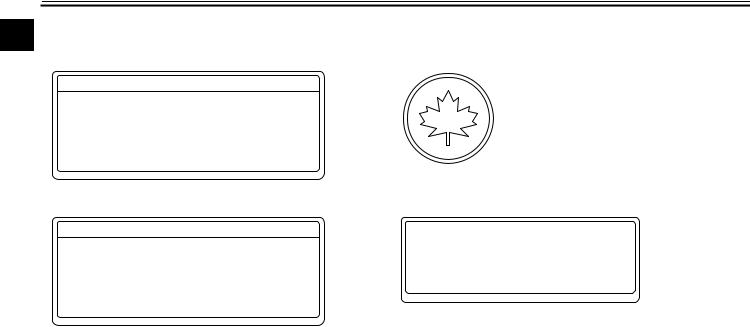
LOCATION OF IMPORTANT LABELS
For Canada
1
1
 WARNING
WARNING
•BEFORE YOU OPERATE THIS VEHICLE, READ THE OWNER’S MANUAL AND ALL LABELS.
•NEVER CARRY A PASSENGER. You increase your risk of losing control if you carry a passenger.
•NEVER OPERATE THIS VEHICLE ON PUBLIC ROADS. You can collide with another vehicle if you operate this vehicle on a public road.
•ALWAYS WEAR AN APPROVED MOTORCYCLE HELMET, eye protection, and protective clothing.
3PT-2118K-A1
2
|
|
|
|
NA |
|
|
|
|
|
|
|
A |
D |
|
|
||
|
|
C |
|
|
A |
• |
|
|
S |
S |
• |
|
|
|
|
N |
|
|
|
|
|
|
|
V |
||
V |
|
|
|
|
|
|
S |
|
|
|
506 |
|
C |
||||
M |
|
|
||||||
|
|
|
|
|
|
|
|
A |
C |
|
|
|
|
|
|
• |
|
• |
|
|
|
|
|
|||
|
|
|
|
|
T |
|||
|
T |
|
|
|
|
R |
||
|
|
R |
A |
|
|
|
|
|
|
|
|
|
|
O |
|
||
|
|
|
|
NSP |
|
|
||
3
 AVERTISSEMENT
AVERTISSEMENT
•LIRE LE MANUEL DU PROPRIETAIRE AINSI QUE TOUTES LES ETIQUETTES AVANT D’UTILISER CE VEHICULE.
•NE JAMAIS TRANSPORTER DE PASSAGER. La conduite avec passager augmente les risques de perte de contrôle.
•NE JAMAIS ROULER SUR DES CHEMINS PUBLICS.
Vous pourriez entrer en collision avec un autre véhicule.
•TOUJOURS PORTER UN CASQUE DE MOTOCYCLISTE APPROUVE, des lunettes et des vêtements de protection.
5PG-2118K-10
4
THIS VEHICLE IS A RESTRICTED USE MOTORCYCLE AND IS NOT INTENDED FOR USE ON PUBLIC HIGHWAYS.
CE VÉHICULE EST UNE MOTOCYCLETTE À USAGE RESTREINT DONT L’USAGE N’EST PAS DESTINÉ AUX VOIES PUBLIQUES.
3PT-2416E-10
1-2
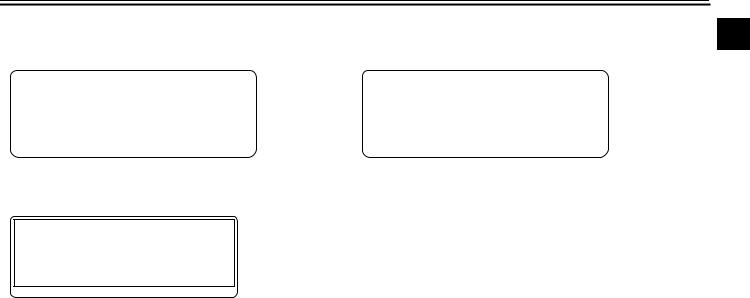
LOCATION OF IMPORTANT LABELS
For Canada
1
5 |
|
|
|
|
6 |
|
|
|
|
||
|
|
|
|
|
|||||||
|
TIRE INFORMATION |
|
|
INFORMATION SUR LES PNEUS |
|||||||
|
Cold tire normal pressure should be set as |
|
La pression des pneus à froid doit normalement |
||||||||
|
follows. |
|
|
|
|
|
être réglée comme suit. |
|
|
||
|
FRONT : |
100 |
kPa, {1.00 |
kgf/cm²}, 15 |
psi |
|
AVANT : |
100 |
kPa, {1.00 |
kgf/cm²}, 15 |
psi |
|
REAR : |
100 |
kPa, {1.00 |
kgf/cm²}, 15 |
psi |
|
ARRIERE : |
100 |
kPa, {1.00 |
kgf/cm²}, 15 |
psi |
|
|
|
|
3RV-21668-A0 |
|
|
|
|
3RV-21668-B0 |
||
7
This spark ignition system meets all requirements of the Canadian Interference Causing Equipment Regulations.
Ce système d’allumage par étincelle de véhicule respecte toutes les exigences du Règlement sur le matériel brouilleur du Canada.
3JK-82377-00
1-3
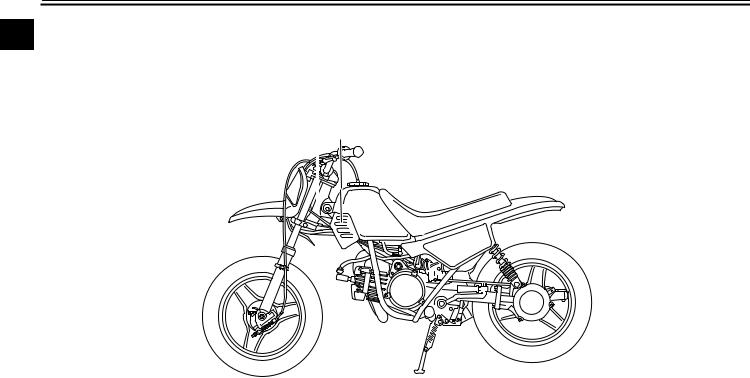
LOCATION OF IMPORTANT LABELS
For Europe
1
1 |
2 |
3 |
4 |
|||||||||||||||||||||||||||
|
|
|
|
|
|
|
|
|
|
|
|
|
|
|
|
|
|
|
|
|
|
|
|
|
|
|
|
|
|
|
|
|
|
|
|
|
|
|
|
|
|
|
|
|
|
|
|
|
|
|
|
|
|
|
|
|
|
|
|
|
|
|
|
|
|
|
|
|
|
|
|
|
|
|
|
|
|
|
|
|
|
|
|
|
|
|
|
|
|
|
|
|
|
|
|
|
|
|
|
|
|
|
|
|
|
|
|
|
|
|
|
|
|
|
|
|
|
|
|
|
|
|
|
|
|
|
|
|
|
|
|
|
|
|
|
|
|
|
|
|
|
|
|
|
|
|
|
|
|
|
|
|
|
|
|
|
|
|
|
|
|
|
|
|
|
|
|
|
|
|
|
|
|
|
|
|
|
|
|
|
|
|
|
|
|
|
|
|
|
|
|
|
|
|
|
|
|
|
|
|
|
|
|
|
|
|
|
|
|
|
|
|
|
|
|
|
1-4
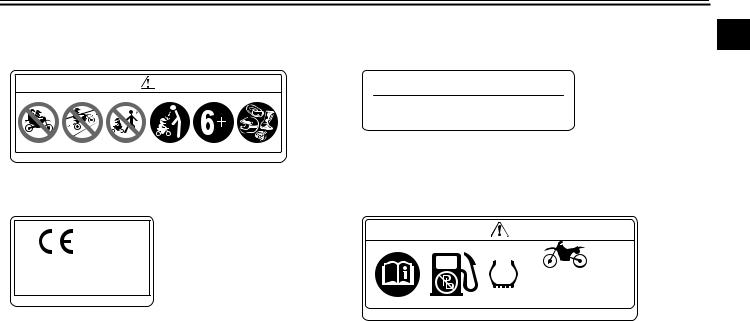
LOCATION OF IMPORTANT LABELS
For Europe
1
1 |
2 |
PW50
2.1 kW |
39 kg |
|
|
5PG-2156A-10 |
|
|
5B6-2816R-00 |
3 |
4 |
EN16029
2014
YAMAHA MOTOR CO., LTD. 2500 SHINGAI, IWATA, JAPAN
5B6-2817L-00

 100 kPa 100 kPa 1.00 kgf/cm² 1.00 kgf/cm²
100 kPa 100 kPa 1.00 kgf/cm² 1.00 kgf/cm²
15 psi |
15 psi |
|
5PG-2816R-00 |
1-5

LOCATION OF IMPORTANT LABELS
Familiarize yourself with the following pictograms and read the explanatory text.
1
|
Read the Owner’s manual. |
|
|
Never use on paved roads. |
|
|
|
|
|
Always use an approved helmet and protective gear.
Use from 6 years old. Operation of this motorcycle by children under the age of 6 increase the risk of severe injury or death.
Adult supervision required for children.
Never carry passengers.
This unit contains highpressure nitrogen gas. Mishandling can cause an explosion. Do not incinerate, puncture or open.
Turn off the main switch after riding to avoid draining the battery.
1-6
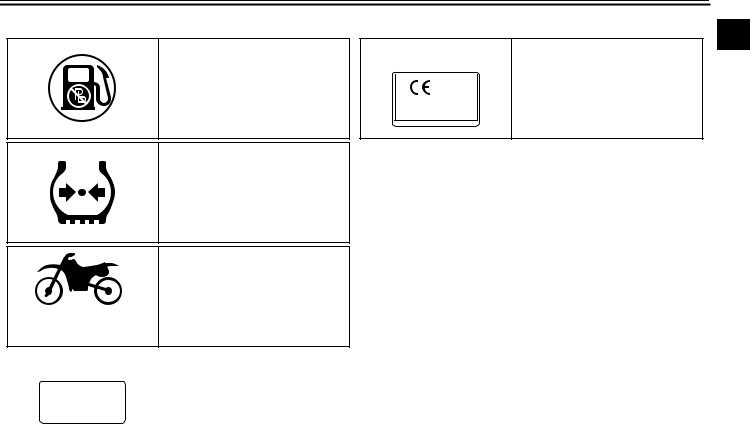
LOCATION OF IMPORTANT LABELS
1
Use unleaded gasoline only. |
1 |
|
|
|
1 Year of construction |
|
|
|
**** |
||
YAMAHA MOTOR CO., LTD. 2500 SHINGAI, IWATA, JAPAN
Measure the tire pressure when the tires are cold.
**.* |
kPa |
*.** |
kgf/cm² |
*.* |
psi |
**.* |
kPa |
*.** |
kgf/cm² |
*.* |
psi |
Adjust the tire pressure. Improper tire pressure can cause loss of control.
Loss of control can result in severe injury or death.
|
|
|
1 |
|
|
1 Model Name |
||
|
|
|
|
|
|
|
||
|
|
|
****** |
|
2 |
Max. Power |
||
|
*** kW *** kg |
|||||||
|
|
Mass In Running Order |
||||||
|
|
|
|
|
|
|
3 |
|
2 |
3 |
|
|
|
||||
|
|
|
|
|
|
|
|
|
1-7
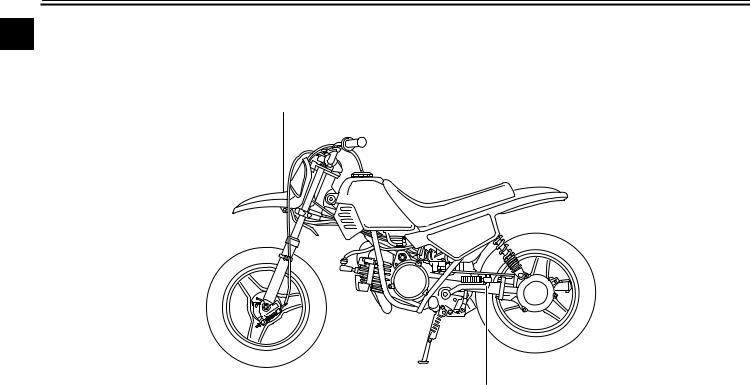
LOCATION OF IMPORTANT LABELS
For Oceania and South Africa
1
1
2
1-8

LOCATION OF IMPORTANT LABELS
For Oceania and South Africa
1
 WARNING
WARNING
•BEFORE YOU OPERATE THIS VEHICLE, READ THE OWNER’S MANUAL AND ALL LABELS.
•NEVER CARRY A PASSENGER. You increase your risk of losing control if you carry a passenger.
•NEVER OPERATE THIS VEHICLE ON PUBLIC ROADS. You can collide with another vehicle if you operate this vehicle on a public road.
•ALWAYS WEAR AN APPROVED MOTORCYCLE HELMET, eye protection, and protective clothing.
3PT-2118K-A1
1
2
TIRE INFORMATION
Cold tire normal pressure should be set as follows.
FRONT : 100 kPa, {1.00 kgf/cm²}, 15 psi REAR : 100 kPa, {1.00 kgf/cm²}, 15 psi
3RV-21668-A0
1-9

 SAFETY INFORMATION
SAFETY INFORMATION
EAU4093C
2Be a Responsible Owner
As the vehicle’s owner, you are responsible for the safe and proper operation of your motorcycle.
Motorcycles are single-track vehicles. Their safe use and operation are dependent upon the use of proper riding techniques as well as the expertise of the operator. Every operator should know the following requirements before riding this motorcycle.
He or she should:
Obtain thorough instructions from a competent source on all aspects of motorcycle operation.
Observe the warnings and maintenance requirements in this Owner’s Manual.
Obtain qualified training in safe and proper riding techniques.
Obtain professional technical service as indicated in this Owner’s Manual and/or when made necessary by mechanical conditions.
Never operate a motorcycle without proper training or instruction. Take a training course. Beginners should receive training from a certified instructor. Contact an authorized motorcycle dealer to find out about the training courses nearest you.
Safe Riding
Perform the pre-operation checks each time you use the vehicle to make sure it is in safe operating condition. Failure to inspect or maintain the vehicle properly increases the possibility of an accident or equipment damage. See page 5-1 for a list of pre-operation checks.
This motorcycle is designed for off-road use only, therefore, it is illegal to operate it on public streets, roads, or highways, even a dirt or gravel one. Off-road use on public lands may be illegal. Please check local regulations before riding.
This motorcycle is designed to carry the operator only. No passengers.
The failure of motorists to detect and recognize motorcycles in traffic is the predominating cause of automobile/motorcycle accidents. Many accidents have been caused by an automobile driver who did not see the motorcycle. Making yourself conspicuous appears to be very effective in reducing the chance of this type of accident.
Therefore:
•Wear a brightly colored jacket.
•Use extra caution when you are approaching and passing through intersections, since intersections are the most likely places for motorcycle accidents to occur.
•Ride where other motorists can see you. Avoid riding in another motorist’s blind spot.
•Never maintain a motorcycle without proper knowledge. Contact an authorized motorcycle dealer to inform you on basic motorcycle maintenance. Certain maintenance can only be carried out by certified staff.
2-1

 SAFETY INFORMATION
SAFETY INFORMATION
Many accidents involve inexperienced operators.
•Make sure that you are qualified and that you only lend your motorcycle to other qualified operators.
•Know your skills and limits. Staying within your limits may help you to avoid an accident.
•We recommend that you practice riding your motorcycle until you have become thoroughly familiar with the motorcycle and all of its controls.
Many accidents have been caused by error of the motorcycle operator. A typical error made by the operator is veering wide on a turn due to excessive speed or undercornering (insufficient lean angle for the speed). Never travel faster than warranted by conditions.
Ride cautiously in unfamiliar areas. You may encounter hidden obstacles that could cause an accident.
The posture of the operator is important for proper control. The operator should keep both hands on the handlebar and both feet on the operator footrests during operation to maintain control of the motorcycle.
Never ride under the influence of alcohol or other drugs.
Protective Apparel
The majority of fatalities from motorcycle accidents are the result of head injuries. The use of a safety helmet is the single most critical factor in the prevention or reduction of head injuries.
Always wear an approved helmet.
Wear a face shield or goggles. Wind in your unprotected eyes could contribute to an impairment of vision that could delay seeing a hazard.
The use of a jacket, heavy boots, trousers, gloves, etc., is effective in preventing or reducing abrasions or lacerations.
Never wear loose-fitting clothes, otherwise they could catch on the control levers, footrests, or wheels
and cause injury or an accident. |
2 |
Always wear protective clothing that covers your legs, ankles, and feet. The engine or exhaust system become very hot during or after operation and can cause burns.
Avoid Carbon Monoxide Poisoning
All engine exhaust contains carbon monoxide, a deadly gas. Breathing carbon monoxide can cause headaches, dizziness, drowsiness, nausea, confusion, and eventually death.
Carbon Monoxide is a colorless, odorless, tasteless gas which may be present even if you do not see or smell any engine exhaust. Deadly levels of carbon monoxide can collect rapidly and you can quickly be overcome and unable to save yourself. Also, deadly levels of carbon monoxide can linger for hours or days in enclosed or poorly ventilated areas. If you experience any symptoms of carbon monoxide poi-
2-2

 SAFETY INFORMATION
SAFETY INFORMATION
soning, leave the area immediately, get fresh air, and SEEK MEDICAL TREATMENT.
2 Do not run engine indoors. Even if you try to ventilate engine exhaust with fans or open windows and doors, carbon monoxide can rapidly reach dangerous levels.
Do not run engine in poorly ventilated or partially enclosed areas such as barns, garages, or carports.
Do not run engine outdoors where engine exhaust can be drawn into a building through openings such as windows and doors.
Loading
Adding accessories to your motorcycle can adversely affect stability and handling if the weight distribution of the motorcycle is changed. To avoid the possibility of an accident, use extreme caution when adding accessories to your motorcycle. Use extra care when riding a motorcycle that has added accessories. Here are some general guidelines to follow if adding accessories to your motorcycle:
Operation of an overloaded vehicle could cause an accident.
The weight of the operator must not exceed 25 kg (55 lb).
Accessory weight should be kept as low and close to the motorcycle as possible. Securely pack your heaviest items as close to the center of the vehicle as possible and make sure to distribute the weight as evenly as possible on both sides of the motorcycle to minimize imbalance or instability.
Shifting weights can create a sudden imbalance. Make sure that accessories are securely attached to the motorcycle before riding. Check accessory mounts frequently.
•Properly adjust the suspension for your load (suspension-ad- justable models only), and check the condition and pressure of your tires.
•Never attach any large or heavy items to the handlebar, front fork, or front fender.
Genuine Yamaha Accessories
Choosing accessories for your vehicle is an important decision. Genuine Yamaha accessories, which are available only from a Yamaha dealer, have been designed, tested, and approved by Yamaha for use on your vehicle.
Many companies with no connection to Yamaha manufacture parts and accessories or offer other modifications for Yamaha vehicles. Yamaha is not in a position to test the products that these aftermarket companies produce. Therefore, Yamaha can neither endorse nor recommend the use of accessories not sold by Yamaha or modifications not specifically recommended by Yamaha, even if sold and installed by a Yamaha dealer.
Aftermarket Parts, Accessories, and Modifications
While you may find aftermarket products similar in design and quality to genuine Yamaha accessories, recognize that some aftermarket accessories or modifications are not suitable because of potential safety hazards to you or others. Installing aftermarket
2-3

 SAFETY INFORMATION
SAFETY INFORMATION
products or having other modifications performed to your vehicle that change any of the vehicle’s design or operation characteristics can put you and others at greater risk of serious injury or death. You are responsible for injuries related to changes in the vehicle.
Keep the following guidelines in mind, as well as those provided under “Loading” when mounting accessories.
Never install accessories that would impair the performance of your motorcycle. Carefully inspect the accessory before using it to make sure that it does not in any way reduce ground clearance or cornering clearance, limit suspension travel, steering travel or control operation.
•Accessories fitted to the handlebar or the front fork area can create instability due to improper weight distribution. If accessories are added to the handlebar or front fork area, they must be as lightweight as possible and should be kept to a minimum.
•Bulky or large accessories may seriously affect the stability of the motorcycle. Wind may attempt to lift the motorcycle, or the motorcycle may become unstable in cross winds.
•Certain accessories can displace the operator from his or her normal riding position. This improper position limits the freedom of movement of the operator and may limit control ability, therefore, such accessories are not recommended.
Use caution when adding electrical accessories. If electrical accessories exceed the capacity of the motorcycle’s electrical system, an electric failure could result, which could cause a dangerous loss of lights or engine power.
Aftermarket Tires and Rims
The tires and rims that came with your motorcycle were designed to match the performance capabilities and to provide the best combination of handling, braking, and comfort. Other
tires, rims, sizes, and combinations |
|
may not be appropriate. Refer to page |
|
7-12 for tire specifications and more in- |
2 |
formation on replacing your tires. |
Transporting the Motorcycle
Be sure to observe following instructions before transporting the motorcycle in another vehicle.
Remove all loose items from the motorcycle.
Check that the fuel cock is in the “S” (stop) position and that there are no fuel leaks.
Point the front wheel straight ahead on the trailer or in the truck bed, and choke it in a rail to prevent movement.
Shift the transmission in gear (for models with a manual transmission).
Secure the motorcycle with tiedowns or suitable straps that are attached to solid parts of the motorcycle, such as the frame or upper front fork triple clamp (and not, for example, to rubber-mounted handlebars or turn signals, or parts that could break). Choose
2-4
